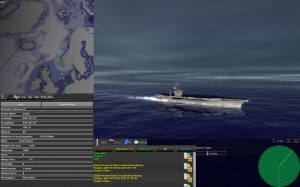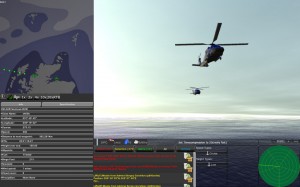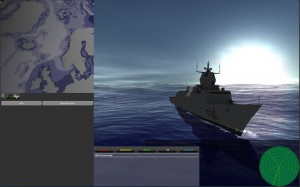“Holy shit! Someone is re-making Harpoon!” is what I said to myself when I first saw the news of this game when we published the launch announcement about it last month, and since I’ve been bouncing around the room in excitement every day after seeing it. Our editorial team decided the only way they could get some peace and quiet was to get me on the hunt for even more information about it.
So, after some tense negotiations and a mutual exchange of cookies, Turbo Tape Games agreed to release Jan Haugland, the co-founder of Turbo Tape Games, and the lead designer of Naval War: Arctic Circle into my clutches for a few minutes.
Here’s our Q and A session;
Thanks for speaking with us today about Naval War: Arctic Circle. I know I’ve followed a lot of the information so far on it, but I’m sure that not all of our readers have, could you sum up the game for us a in few sentences?
Naval War: Arctic Circle is a real time strategy game where you control the contemporary navies and air forces of the powers in the North Atlantic region. In the very near future, competition over scarce resources in the Arctic region – oil and gas, transportation routes – escalates towards an armed conflict.
As a player, you take control of naval and aerial units from this region’s actual military hardware, and try to meet different mission objectives. The scenarios will range from small patrol craft skirmishes in the Norwegian fjords via submarine hunting and escort missions to large scale engagements involving surface task forces, aircraft carrier groups and land based aircraft.
You will also be able to engage other players on the internet to find out who is the best naval commander.
We place a lot of emphasis on realism in this game. We want to reasonably accurately simulate actual, real-world platforms, including their speed, range, and the various sensors and weapons they actually have. If you are an enthusiast, you should recognise the capabilities of the F-22, an Arleigh Burke class destroyer or a Kirov class battle-cruiser, and take advantage of their real world strengths and weaknesses. You should recognise their real life sensor systems – radars, infrared and sonar – and their weapons, and use them.
At the same time, NWAC is first and foremost an entertainment game, not a simulator. We do take shortcuts and simplify the subject matter to make it enjoyable. We do recognise that to many fans, accuracy is important, but we want this to be a game that appeals to any RTS or war game enthusiast.
The obvious comparison that people think of when you see the game is Harpoon, which was a very detailed simulation of naval warfare, but wasn’t always much of a game. How different or similar is the game to things like Fleet Command, Harpoon etc?
Harpoon is indeed the original inspiration. I played the PC game Harpoon for many, many years, well into the era when it was graphically quite obsolete. I also played more conventional RTS games, like Age of Empires, Command & Conquer and especially Starcraft. The vision for Naval War was to have these games meet somewhere in the middle. When we combine the connection to reality that follows from actually having real world units and countries in the game with the immediate action and user-friendly interface of a modern RTS, that makes for a very exciting game.
Creating a game with such a large scale and scope to it is a pretty big task, what influenced you to create a game set in this very modern naval environment ?
The play area of the game (not every mission, obviously) is around 35 million square kilometres, a vastly larger area than what other RTS games have to deal with. We also simulate a real, spherical Earth, and dynamic weather and environment. This has given us a few technical challenges in development, obviously, but more than this it is a challenge for the user interface. The normal zoom & pan may not be the optimal solution. On the open ocean you can pan forever without seeing anything. We have come up with some very neat solutions that we are convinced will give the user the level of immediacy and control the subject matter demands.
 Could you explain how you balance the detailed needs of a naval simulation and all the various things whilst keeping it fun and enjoyable to play?
Could you explain how you balance the detailed needs of a naval simulation and all the various things whilst keeping it fun and enjoyable to play?
As I alluded to earlier, we’ve made it clear from the start, in the design process, that this is an entertainment game. In some specific situations, realism has to go to make it fun. For example, you don’t need to maneuver an aircraft carrier into the wind to launch aircraft. Harpoon the PC game, unlike Harpoon the table top game, did this simplification too, if I am not mistaken. There is a lot more mess in a real life aircraft carrier, or airport, about how to allocate maintenance crews and aircraft readiness levels, that we make vastly simpler and more fun for the player. We don’t simulate the workflow and communication channels inside a ship; we see one unit as an entity. We also ignore the fact that you can’t communicate with submarines once they are submerged. That would make subs far less effective in this game, and make the game less enjoyable. And, obviously, you can lose a game in NWAC without ending up swimming in the middle of the Atlantic Ocean. Players only want so much realism!
The game is still more complex than your average RTS, obviously. A major component of almost any game session is how you outfit your aircraft. If you give all your fighters an air-to-air loadout, you will have no way to engage surface ships or an airport, and vice versa. You can change loadouts later, but that takes time, and your aircraft can’t be launched until they’re ready. Especially in online pvp, this gives room for a lot of tactics and counter-tactics, and of course a lot of opportunity for feints and deception. The complexity of Naval War: Arctic Circle adds to the fun, it doesn’t make it a chore to play.
Within the Northern Atlantic and Arctic region that the game covers what nations are involved in the fighting? Is it purely a NATO vs Russia game, or will the smaller nations and their equipment feature as well? As a British guy, I’m hoping to see some involvement from our forces, especially with the new carriers we have in the next few years!
Britain is a prominent part of NWAC, including the new Queen Elizabeth class aircraft carrier, the Type 26 Frigate and the Daring class destroyer. The Nordic countries also participate with their modern naval units, and we’ll see what other nations we can include.
When we first looked at the actual geopolitics and armed forces, we noticed the USA is, as gamers would say, vastly overpowered. We’re still developing the storyline alongside the game itself, but it’s clear that there must be political and other reasons to keep the US outside of the fun for a while. Eventually, of course, if you have a war, the Americans will turn up, so you’ll be able to play with Nimitz class super-carriers, F-22 stealth fighters, Arleigh Burke destroyers, Virginia class submarines, and so on.
We’re trying to avoid the standard NATO vs Russia story, making it more complex, but obviously you as a player can have skirmishes and online experiences mixing and matching these factions as you like. I think everybody will want to play Russia. They have the most awesome ships ever built.
 We can probably guess the standard range of planes, ships etc. that will feature. What sort of experimental and prototype units will we see in the game? Will there also be land bases, ports, airbases and so on as well?
We can probably guess the standard range of planes, ships etc. that will feature. What sort of experimental and prototype units will we see in the game? Will there also be land bases, ports, airbases and so on as well?
There will be air ports, sea ports, radar stations and SAM batteries on land, but otherwise the game-play concentrates on naval and aerial units. There will be no tanks, to put it like that.
What units will be included is one of the most common questions we receive on the forum, every day, and we still haven’t decided on the full list.
There is a lot of defense news about experimental weapons like energy beams and rail runs, but we’ll run a quite conservative selection. There is a long way from a feasibility study to a deployed system, so I think that’s pretty realistic. Concluding that the F-35C will actually be finished and work as advertised is about as far as we are willing to stretch it!
One of the things you’ve said about the game before is that smaller units can be very deadly if they are able to get near carrier groups and so on. How are you balancing this? Will there be ways for players to defend against these kind of attacks so that the first person to locate and attack the other side doesn’t always win?
This is indeed one of the big differences between a realistic RTS like Naval War and more conventional designs in the same genre. In Starcraft, for example, almost any unit can take a few shots from even much more powerful units. In NWAC, the weapons are vastly more powerful, both in range and in damage. For aircraft, one hit is almost always a kill. Submarines are also necessarily very vulnerable once detected. Even a large surface ship can only take a handful of missiles before it sinks. So, if you get a single submarine through the shield around a carrier group, you can almost wipe it out in an instant.
This is still, however, quite balanced, since real world navies have known this forever and taken their precautions. Subs are hard to detect, but when running stealthy they can only crawl. So having a sub in the right position depends on predicting enemy movement. The counter to this is being unpredictable, and of course sending your ASW helicopters in first.
Aircraft are in the same way enormously powerful, but very fragile. A wing of long range bombers can essentially wipe you off the map in a few minutes, but they are like fish in a barrel for a handful of fighters. Cruise missiles, the main weapons of this game, can be shot down. To take out a large surface task force you’ll have to saturate the defences with sufficient firepower to get through a barrage of anti-air missiles and gatling guns. You do not only have to be the first to locate the enemy, you must be ready to amass your entire arsenal for a single decisive attack. There is a lot the enemy can do to prevent you from succeeding even when you know their position.
Historically the NATO forces have had a very powerful advantage in naval combat with their powerful carrier groups. What ways are there within the game to deal with such strong forces like this?
 That is true. NATO, or more specifically the US, are vastly more powerful than everybody else put together. But they have their political priorities, their economic recessions, other wars, so the forces that meet in NWAC will be fairly balanced. In the case of pvp, very carefully balanced.
That is true. NATO, or more specifically the US, are vastly more powerful than everybody else put together. But they have their political priorities, their economic recessions, other wars, so the forces that meet in NWAC will be fairly balanced. In the case of pvp, very carefully balanced.
Russia, on the other hand, has the advantage of being close to the battlefield, and can bring a serious threat of long range bombers from airfields on land.
The Nordic countries, being inferior in numbers, will in a similar way have an advantage in the coastal waters, by having small, stealthy units perfectly suited for dealing damage way beyond their tonnage.
Within the campaign, does the player have any control over what units they start each mission with? Will units keep damage or gain experience that is carried between the missions?
We still haven’t perfectly nailed how this will work, it is possible we’ll have competitive game modes with flexible initial unit compositions.
There will not be any experience gains for units in the mission or the campaign.
One of the things that can add a lot of variety to a game is having the missions and scenarios play differently each time – will the missions always play out in the same ways, or will there be some randomness to the AI’s behaviour so that it’s units don’t always do the same things and take the same routes each time you play? Would it be possible for the different sides to sometimes start with different units to reflect the uncertain nature of combat and intelligence about enemy forces etc?
There is initial variety in the missions, with some random variation of where exactly forces are deployed. Otherwise there will be minimal replay value. This variation actually makes the AI react quite differently from game to game. The exact timing of when the AI detects units causes changes to how it reacts to it, since it may have different forces available at different times. So the game experience is certainly varied.
We may also make the scenarios flexible, with probabilities attached to units. Both Harpoon and Fleet Command does this. We’ll see.
Are there any ways to repair units or replace/construct new ones, or is the starting assignment what you have to work with each time?
Components (runways, weapons and sensors) that are damaged are repaired automatically. We don’t have any other provisions for repair. Repairing a damaged ship hull takes months, and in a real time game that would be stretching your patience!
From the screen shots that we’ve seen so far, there’s quite a few calm seas, but you’ve also said that there will be realistic weather – will we be able to experience proper storms with strong waves that make combat and detection of enemies more difficult?
 There is support for that in the engine. At higher sea states, you’ll have many limitations in the gameplay. For example, aircraft may not be able to take off from sea based platforms, or maybe not at all. Sea skimming missiles don’t work. Many sensors are virtually blind. This is certainly a part of the game, but obviously, in hurricane strength winds you really have nothing to do, so it may not be such a viable game option.
There is support for that in the engine. At higher sea states, you’ll have many limitations in the gameplay. For example, aircraft may not be able to take off from sea based platforms, or maybe not at all. Sea skimming missiles don’t work. Many sensors are virtually blind. This is certainly a part of the game, but obviously, in hurricane strength winds you really have nothing to do, so it may not be such a viable game option.
How are the multiplayer elements of the game going to work? Will we be able to do co-operative games of the campaign with friends, or just single missions against the other side? What’s the maximum number of players we can expect in a game?
We promise player vs player, two-player competitive, on release day. A lot of people have asked us about cooperative play as well as games with a lot of players (as in, say, 4vs4). These things are possible, but probably as a post-release addition if there is enough interest for it.
One final question – what’s the part of the game that you are most proud of so far? What features do you think will really appeal to players?
We’re really proud of seeing that the game we thought up quite some time ago is taking shape and it looks and feels just as awesome as we hoped. Having a vision is one thing, but creating game mechanics to bring that vision to life is something different. The team we have here at Turbo Tape Games is really awesome. Very talented technically, very creative, and a great bunch of people all around that gives us the extra push to do a good job every day.
War games are about awesome power, and strategy is about hard choices and nasty surprises. Naval War: Arctic Circle will deliver that feeling of controlling all these powerful great machines of war, and the immense satisfaction of having a good plan coming together in spectacular pyrotechnics.
Thank you very much for your time today, I’m very much looking forward to seeing the game and what you do with it.
Thank you for your interest, and looking forward to having more to share with you and your audience!